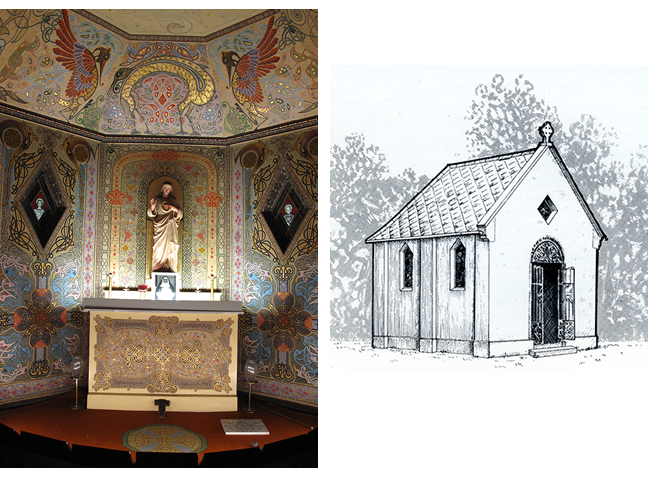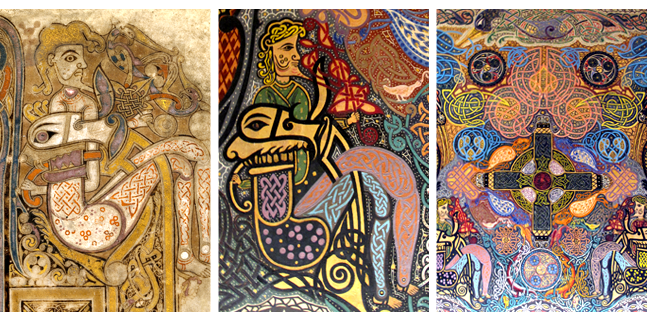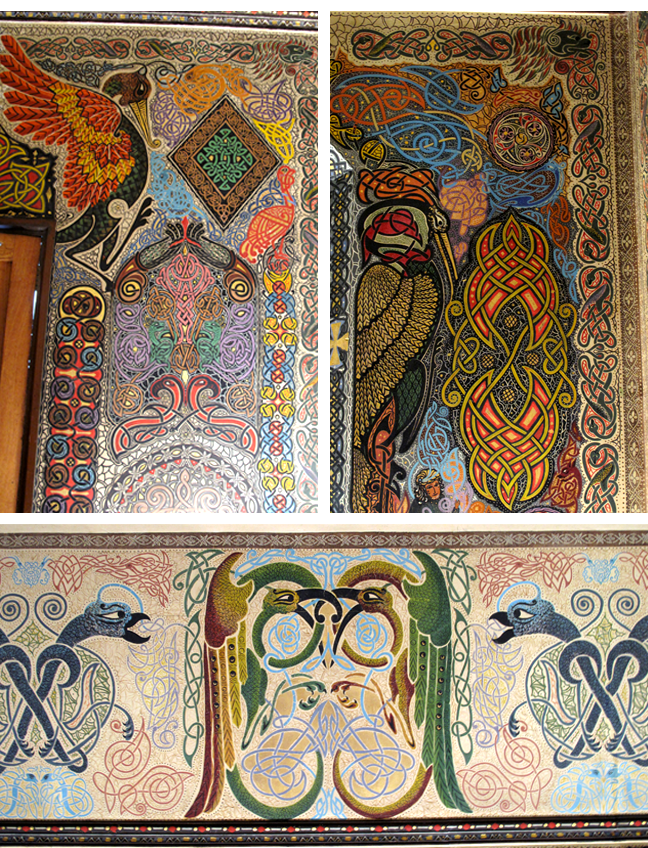A shrine of ‘Celtic’ art
A shrine of ‘Celtic’ art
114 comments
Hidden away off a residential street in the Dublin suburb of Dún Laoghaire is a masterpiece of painted decoration inspired by the Book of Kells.
 Fig 1. The high altar in the oratory. Photo: Rachel Moss. Fig 2. Artist’s impression of the original exterior of the oratory (a modern building has now been constructed around it). © Irish Dominican Sisters.
Fig 1. The high altar in the oratory. Photo: Rachel Moss. Fig 2. Artist’s impression of the original exterior of the oratory (a modern building has now been constructed around it). © Irish Dominican Sisters.
The Oratory of the Sacred Heart was built in the grounds of the Dominican convent at Dún Laoghaire in 1919, in memory of the Irishmen killed during World War 1. Modest both in scale and architectural adornment, the decoration of its interior was undertaken by one of the community’s nuns, Sr Mary Concepta Lynch, between 1920 and her death in 1936. Born Lily Lynch, Sr Mary Concepta was the daughter of an illustrator, Thomas Joseph Lynch, and had been trained by him in the art of ‘Celtic’ design.
 Fig 3. Detail from the opening of the Gospel of Mark in the Book of Kells fol. 130r. Photo: Rachel Moss. Fig 4. Sr Mary Concept’s copy of the detail from fol. 130r. Photo: Rachel Moss. Fig 5. Detail of the south wall of the oratory. Photo: Rachel Moss.
Fig 3. Detail from the opening of the Gospel of Mark in the Book of Kells fol. 130r. Photo: Rachel Moss. Fig 4. Sr Mary Concept’s copy of the detail from fol. 130r. Photo: Rachel Moss. Fig 5. Detail of the south wall of the oratory. Photo: Rachel Moss.
Sr Mary Concepta used old window blinds from the convent to first draw out her designs and then create stencils, allowing her to ‘map’ her designs on the walls and ceiling of the little chapel. Some elements were inspired directly by the Book of Kells, such as the figure being bitten by a lion, found at the opening of St Mark’s Gospel fol. 130r, decorative borders with lions’ heads and intertwined birds and circles filled with Celtic spirals.
 Fig 6. Detail of the oratory decoration showing a complex interlace design only loosely based on the Book of Kells. Photo: Rachel Moss. Fig 7. Details such as the circle filled with spirals and biting lion’s head in the top right corner take more direct inspiration from the Book of Kells. Photo: Rachel Moss. Fig 8. This design is located close to the ceiling of the oratory. It is less densely coloured and may be unfinished. Photo: Rachel Moss.
Fig 6. Detail of the oratory decoration showing a complex interlace design only loosely based on the Book of Kells. Photo: Rachel Moss. Fig 7. Details such as the circle filled with spirals and biting lion’s head in the top right corner take more direct inspiration from the Book of Kells. Photo: Rachel Moss. Fig 8. This design is located close to the ceiling of the oratory. It is less densely coloured and may be unfinished. Photo: Rachel Moss.
But Sr Mary Concepta was not a mere copyist, and many of her designs are original, taking their lead from the Book of Kells in terms of the density, complexity and colour of the ornament, but drawing inspiration too from the sinuous curves of the Art Nouveau style, then at the height of its popularity.
Together with her work on the oratory, Sr Mary Concepta taught art at the Dominican convent and a number of her other designs and teaching aids survive. One, painted on linen, is a prayer to St Colum Cille, requesting assistance for contemporary artists working in the ‘Celtic’ manner.
 Fig 9. A painted linen banner decorated by Sr Mary Concepta. © Irish Dominican Sisters.
Fig 9. A painted linen banner decorated by Sr Mary Concepta. © Irish Dominican Sisters.Text of the prayer: Saint Columcille
A prince was he St Columcille
A poet too with words at will
A genius born, an artist rare
All work he did with wonderous care
He taught his monks the Celtic art
Dots curves and lines, each took a part
And so to us and to the nation
Came down from them illumination
O may the spirit of this saint
Watch o’er us, guide us, as we paint
New lines, new tints, tho’ we be late
The Book of Kells we’ll imitate
Creation of the monks of old
In green and scarlet, red and gold
The tracery so firm, so fine
Seemed wrought indeed by hands divine
© Trinity College Dublin

Postar um comentário